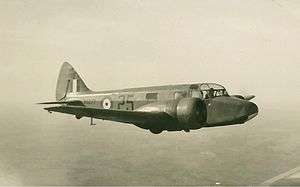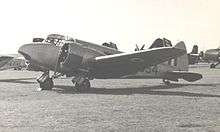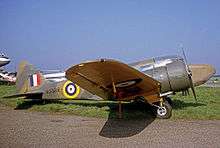Airspeed Oxford
| AS.10 Oxford | |
|---|---|
 | |
| Oxford II inflight over Saskatchewan, Canada in 1942 | |
| Role | Training aircraft |
| Manufacturer | Airspeed Ltd. |
| First flight | 19 June 1937 |
| Primary user | Royal Air Force |
| Number built | 8,586 |
| Developed from | Airspeed Envoy |
| Variants | Airspeed Consul |
The Airspeed AS.10 Oxford is a twin-engine aircraft used for training British Commonwealth aircrews in navigation, radio-operating, bombing and gunnery during the Second World War.
Design and development

With the expansion of the Royal Air Force in the 1930s the service had an operational requirement (OR.42) for an advanced training aircraft, particularly for crews destined for bomber aircraft. The Avro Anson was considered for the role but it was thought an aircraft more difficult to fly was needed and Air Ministry Specification T.23/36 was issued on 10 July 1936 to Airspeed for a twin-engined training aircraft to meet OR.42.[1]
The Oxford, built to Specification T.23/36, was based on Airspeed's commercial 8-seater aircraft, the AS.6 Envoy, designed by Hessell Tiltman. Seven Envoys had been modified for the South African Air Force as the "Convertible Envoy", which could be equipped at short notice with bomb racks and with a machine-gun in a hand-operated Armstrong Whitworth dorsal turret.
The Oxford was a low-wing cantilever monoplane, with a semi-monocoque constructed fuselage and wooden tail unit. Its main landing gear struts retracted into the engine nacelles. It used conventional landing gear configuration. With a normal crew of three, the seating could be changed to suit the training role. The cockpit had dual controls and two seats for a pilot and either a navigator or second pilot. When used for bomb aimer training, the second set of controls was removed and the space was used for a prone bomb-aimer. When used as a navigation trainer, the second seat was pushed back to line up with the chart table. Aft of the cockpit was a wireless operator station, facing aft on the starboard side of the fuselage. In the Oxford I a dorsal turret was located amidships. The aircraft could be used for training navigators, bomb-aimers, wireless operators, air gunners and camera operators. The Oxford could also be used as an air ambulance.[2]
Orders were placed for a first batch of 136 aircraft, to allow a more economical flow-line production at the Portsmouth factory. The first prototype aircraft L4534 first flew at Portsmouth on 19 June 1937. Two variants were planned, the Mark I as a general-purpose training aircraft with a dorsal gun turret and the Mark II without a turret but fitted with dual-controls. As further large contracts for the aircraft were placed with Airspeed, (100 Mk Is and 100 Mk IIs) it was arranged that de Havilland Aircraft would build them at Hatfield later, to meet the demands for Oxfords for training. Other companies also built the aircraft.[1]
A total of 8,586 Oxfords were built, with 4,411 by Airspeed at its Portsmouth factory, 550 at the Airspeed-run shadow factory at Christchurch, Dorset, 1,515 by de Havilland at Hatfield, 1,360 by Percival Aircraft at Luton and 750 by Standard Motors at Coventry.[3]
Operational history

The Oxford (nicknamed the 'Ox-box') [4] was used to prepare complete aircrews for RAF Bomber Command and could simultaneously train pilots, navigators, bomb aimers, gunners and radio operators on the same flight. In addition to training duties, Oxfords were used in communications and anti-submarine roles and as ambulances in the Middle East.
The Oxford was the preferred trainer for the Empire Air Training Scheme (EATS) and British Commonwealth Air Training Plan (BCATP), which sent thousands of potential aircrew to Canada for training. 27 Oxfords were on the strength of No 4 Flying Training School RAF Habbaniya, Iraq in early 1941 and some were converted locally, for use as light bombers to help in the defence of the School against Iraqi forces.[5]
In 1941, the aviator Amy Johnson went missing in an Airspeed Oxford, presumably crashing into the Thames Estuary.
After the war, 152 surplus Oxfords were converted into small 6-seat commercial airliners called the AS.65 Consul. A few Oxfords were acquired by the Hellenic Air Force and used during the Greek Civil War by No. 355 Squadron RHAF.
Although the Oxford was equipped with fixed-pitch wooden or Fairey-Reed metal propellers, the cockpit contained a propeller pitch lever, which had to be moved from "Coarse" to "Fine" for landing. This was to reinforce this important step for trainee pilots.
Oxfords continued to serve the Royal Air Force as trainers and light transports until the last was withdrawn from service in 1956. Some were sold for use by overseas air arms, including the Royal Belgian Air Force.
Australia
From November 1940, the Royal Australian Air Force received 391 Oxford I and IIs from RAF contracts for use in Australia.[6] Most of the survivors were sold in the early 1950s.[7]
Canada
The Royal Canadian Air Force ordered 25 Oxford Is in 1938. They were taken from RAF stocks and shipped to Canada in 1939 and assembled by Canadian Vickers at Montreal. Issued to the Central Flying School, they were later joined by large numbers of RAF aircraft to equip the Service Flying Training Schools.[8]
New Zealand
New Zealand was one of the first nations to order the Oxford in 1937 with a contract for five Oxford Is; the fifth aircraft was modified as a survey aircraft. They were delivered to New Zealand by sea and assembled at RNZAF Hobsonville at the end of 1938. The RNZAF placed further orders for six and then 30 Oxfords. With the start of the Commonwealth Air Training Plan a further 140 aircraft were allocated, which included the last batch of 30 ordered.[9] In total the RNZAF operated 299 Oxfords between 1938 and 1952.
South Africa
As part of the Commonwealth Air Training Plan, the South African Air Force was allocated nearly 700 Oxfords which started to arrive in South Africa from November 1940. Due to the intense training, 256 aircraft were lost to accidents. Most survivors were withdrawn in 1945 and had been sold by 1947.[10]
United States
The United States Army Air Force units used 137 Oxfords on loan from the Royal Air Force. Mostly used as general-purpose communications aircraft in the United Kingdom and from June 1942 they were also used for Beam Approach Training. By the end of 1944, American types were available and all had been returned to the Royal Air Force by the end of the year. A small number had also been loaned to the USAAF in Australia by the Royal Australian Air Force. Two Oxfords were used by the United States Navy in the United Kingdom as communications aircraft.[11]
Other users

- Belgium
- When the Belgian section of the Royal Air Force returned to Belgian control as the Militaire Vliegwezen (became the Belgian Air Force in 1949), the RAF donated thirty Oxfords to form a flying training school. They were used until the late 1950s with the last aircraft being donated to the Brussels War Museum in 1960.[11]
- Belgian Congo
- In April 1944 six Oxfords were transferred to the Force Publique in the Belgian Congo, they were with withdrawn from use in 1955.[11]
- Burma
- At least 15 Oxfords along with some Consuls were supplied to the Union of Burma Air Force in the late 1940s with some being modified to carry pod-mounted forward facing machine guns and rocket projectiles.[11]
- Ceylon
- Three former RAF Oxfords were delivered to the Royal Ceylon Air Force in 1953.[11]
- Czechoslovakia
- It is reported that some Oxfords were given the type code D42 and were used for bombing training.[11]
- Denmark
- From the end of 1946 the Danish Air Force received 44 former RAF Oxfords for advanced flying training at Karup, they were also used for communications and aerial photography, they were all withdrawn by 1956.[11]
- Egypt
- RAF Oxfords where loaned to the Royal Egyptian Air Force but at least one was transferred in 1948.[11]
- France
- The Free French Air Force in West Africa received five new Oxfords in 1944 and were used until 1946.[11]
- Greece
- The Royal Hellenic Air Force received at least 33 Oxfords in 1947 for transportand aerial photography.[11]
- India
- When India became independent in December 1947 nine Oxfords were transferred to the Royal Indian Air Force, later Indian Air Force from December 1949.[11]
- Iran
- Three Oxfords were delivered to the Imperial Iranian Air Force.[11]
- Israel
- Three Oxfords and eleven Consuls were used by the Central Flying School of the Israeli Defence Force Air Force for twin-engined training in the early 1950s.[11]
- Netherlands
- From May 1946 the Royal Netherlands Air Force received 28 Oxfords for aircrew training, they had been withdrawn from use by 1952.[11]
- In October 1947 the Royal Netherlands Navy received three Oxfords for multi-engined and navigation training from Valkenburg, two former Royal Netherlands Air Force aircraft were added in 1951, all were withdrawn by 1952.[11]
- Norway
- The Royal Norwegian Air Force bought twenty surplus Oxfords from the RAF in 1947.[11]
- Portugal
- The Portuguese Army and Navy each received six Oxfords in 1943 under Operation Oatmeal, by the time the Portuguese Air Force was formed in 1952 four aircraft were still in service.[11]
- Turkey
- The Turkish Air Force were supplied with 50 Oxford Is in 1943 and these were later joined by twenty more between 1946 and 1947. They were replaced by the AT-11 in the early 1950s and the survivors were scrapped.[11]
- Yugoslavia
- Five Oxfords were supplied to the Yugoslav Air Force between 1951 and 1958 by Norway under the Mutual Defence Aid Program and used for twin-engined training of Mosquito crews.[11]
Variants
- AS.10 Oxford I
- To produce the Oxford I for the Royal Air Force, Airspeed increased the wingspan, modified the nose and employed fully cowled Armstrong Siddeley Cheetah IX radial engines of 350 hp (265 kW). The first Mark I flew on 19 June 1937 and entered service with the Central Flying School in November of that year. By the start of the war, about 300 Mk I Oxfords were in service with the RAF, while a number were also being used by the Royal New Zealand Air Force to train pilots for the RAF.
- AS.10 Oxford II
- The prevalence of powered turrets by the start of the war meant the Oxford's role as a gunnery trainer lapsed. The Oxford II, 70 of which were in service by the start of the war, dispensed with the turret and were used primarily as radio and navigation trainers.
- AS.10 Oxford III
- Powered by two Cheetah XV engines with 425 hp (315 kW) and Rotol constant-speed propellers, used for navigation and radio training.
- AS.10 Oxford IV
- Flying test-bed for de Havilland Gipsy Queen IV engines.
- Oxford T.II
- Only 9 of these were built, eight of them being conversions of Mk Is.
- AS.40 Oxford
- Civil conversion for radio research, two built.
- AS.41 Oxford
- Used by Miles Aircraft as a flying test-bed for Alvis Leonides engine, one conversion.
- AS.42 Oxford
- Oxford I to meet Specification T.39/37 for New Zealand.
- AS.43 Oxford
- Survey variant of the AS.42
- AS.46 Oxford V
- The final variant, upgraded to Pratt & Whitney R-985 radial engines with 450 hp (335 kW) and Hamilton-Standard variable-pitch propellers. Many Mark I and II Oxfords were upgraded to the Mark V standard.
- AS.65 Consul
- After the end of WWII, over 150 aircraft surplus ex-RAF Oxfords were converted for civilian transport operation; this type was known as the Airspeed Consul.
Operators
Survivors
As of April 2014 no Oxfords are in airworthy condition however there are restoration-to-fly projects in New Zealand, as well as components held by several private individuals and the RNZAF Museum for possible incorporation into future rebuilds.
Museum display
- Oxford I 016/MP455 on display at the Brussels War Museum
- Oxford I PK286/G-AIKR, originally configured as an Airspeed Consul, was restored for static display at the Royal New Zealand Air Force Museum, Wigram, and is on long-term loan to that institution from the Canada Aviation Museum.[13] Parts of NZ1289/V3267 and NZ1302/P8846 are reportedly held by the RNZAF Museum[14] and may have been used in the restoration. The finished aircraft went on display in February 2016.[15]
- wreckage from Oxford I NZ277/P2030, which crashed in October 1942, on display at the Taranaki Aviation, Transport and Technology Museum near New Plymouth
- Oxford I MP425/G-AITB on display at the Royal Air Force Museum London, Hendon
- Oxford I V3388/G-AHTW on display at the Imperial War Museum, Duxford, Cambs
Under restoration/stored
- An Oxford was being restored to static condition at Moose Jaw Canada for a private collector, by volunteers connected with the Western Development Museum, as of May 2005 but its current status is not known[16]
- Oxford II NZ1332/AP414 is under restoration to static condition by the Subritzky family of Dairy Flat near Auckland
- An Oxford project is under restoration to airworthy by Stuart Atkinson at Papakura, Auckland using parts from several airframes including Oxford I NZ2155/PG942[17]
- Oxford R6029/G-AJLR, configured as Consul VR-SCD, was in late 2005 under restoration for Singapore Airlines by the Croydon Aircraft Company at Mandeville, however its current status is not known[17]
- Oxford I ED290/G-AITF is under restoration to a taxiable condition at the South African Air Force Museum at Port Elizabeth[18]
- Oxford V EB518 is stored at Baxterley[19]
Specifications (Mk I)

Data from Modern Trainer[20]
General characteristics
- Crew: 3
- Length: 34 ft 6 in (10.52 m)
- Wingspan: 53 ft 4 in (16.26 m)
- Height: 11 ft 1 in (3.38 m)
- Wing area: 348 ft²[21] (32.3 m²)
- Empty weight: 5,322 lb (2,419 kg)
- Loaded weight: 7,500 lb (3,409 kg)
- Powerplant: 2 × Armstrong Siddeley Cheetah X radial engines, 350 hp (261 kW) each
Performance
- Maximum speed: 192 mph (167 knots, 309 km/h) at 8,000 ft (2,440 m)
- Endurance: 5.5 hr
- Service ceiling: 23,550 ft (7,180 m)
- Rate of climb: 1,340 ft/min (6.8 m/s)
Armament
- Guns: 0.303 in (7.7 mm) Vickers K machine gun in dorsal turret
- Bombs: 16× 11.5 lb (5 kg) practice bombs carried externally
See also
- Related development
- Aircraft of comparable role, configuration and era
- Related lists
References
- Notes
- Citations
- 1 2 Hamlin 2001, pp. 18-26
- ↑ Bridgman 1988
- ↑ Middleton Aeroplane Monthly June 1980, pp. 325–326.
- ↑ Wilson 1998
- ↑ A V-M A G Dudgeon CBE DFC The War That Never Was Airlife Publishing, 1991
- ↑ Wilson, Stewart (1994). Military Aircraft of Australia. Weston Creek, Australia: Aerospace Publications. p. 216. ISBN 1875671080.
- 1 2 Hamlin 2001, pp. 198-209
- 1 2 Hamlin 2001, pp. 209-225
- 1 2 Hamlin 2001, pp. 225-233
- 1 2 Hamlin 2001, pp. 233-245
- 1 2 3 4 5 6 7 8 9 10 11 12 13 14 15 16 17 18 19 20 21 22 23 24 25 26 27 28 29 30 31 32 33 34 35 36 37 38 39 40 Hamlin 2001, pp. 246-259
- ↑ Jefford 1988, p. 137.
- ↑ "Air Force Museum of New Zealand - Oxford"http://www.airforcemuseum.co.nz/main/AirspeedOxford/
- ↑ "ADF-Serials"http://adf-serials.com/nz-serials/
- ↑ Radio New Zealand - Classic Oxford for Air Force Museum http://www.radionz.co.nz/news/regional/295687/classic-oxford-for-air-force-museum Retrieved 27 July 2016
- ↑ "Key Publishing Forum - Airspeed Oxford help (pg2)"http://forum.keypublishing.com/showthread.php?51641-airspeed-Oxford-Help/page2
- 1 2 "Key Publishing Forum - Airspeed Oxford help"http://forum.keypublishing.com/showthread.php?51641-airspeed-Oxford-Help
- ↑ "SAAF Museum website"http://saafmuseum.org.za/category/pe-updates/
- ↑ "Demobbed - Airspeed Oxford"http://www.demobbed.org.uk/aircraft.php?type=822
- ↑ Flight 30 June 1938, p. 630.
- ↑ Thetford 1957, pp. 18–19.
- Bibliography
- Bridgman, Leonard. Jane's Fighting Aircraft of World War II. New York: Crescent Books, 1988. ISBN 0-517-67964-7.
- Flintham, V. (1990). Air Wars and Aircraft: a detailed record of air combat, 1945 to the present. London : Arms and Armour. ISBN 0-85368-779-X.
- Gunston, Bill. Classic World War II Aircraft Cutaways. London: Osprey, 1995. ISBN 1-85532-526-8.
- Hamlin, John F. The Oxford, Consul & Envoy File. Tunbridge Wells, Kent, UK: Air-Britain (Historians) Ltd., 2001. ISBN 0-85130-289-0.
- Jefford, C.G, MBE,BA ,RAF (Retd). RAF Squadrons, a Comprehensive Record of the Movement and Equipment of all RAF Squadrons and their Antecedents since 1912. Shrewsbury, Shropshire, UK: Airlife Publishing, 1988. ISBN 1-84037-141-2.
- Middleton, Don. "RAF Piston Trainers No 9 Airspeed Oxford–Part One". Aeroplane Monthly, May 1980, Volume 9 No 5, ISSN 0143-7240. pp. 242–249.
- Middleton, Don. "RAF Piston Trainers No 9 Airspeed Oxford–Part Two". Aeroplane Monthly, June 1980, Volume 9 No 6, ISSN 0143-7240. pp. 322–327.
- "Modern Trainer." Flight, 30 June 1938, pp. 628–632.
- Pacco, John. "Airspeed Oxford Mk.I" Belgisch Leger/Armee Belge: Het militair Vliegwezen/l'Aeronautique militaire 1930-1940. Artselaar, Belgium, 2003, p. 89. ISBN 90-801136-6-2.
- Rawlings, John D.R. "The Airspeed Oxford". Aircraft in Profile, Volume 11. Windsor, Berkshire, UK: Profile Publications Ltd., 1971.
- Thetford, Owen. Aircraft of the Royal Air Force 1918–57. London: Putnam, 1957.
- Wilson, Stewart. Aircraft of WWII. Fyshwick, ACT, Australia: Aerospace Publications Pty Ltd., 1998. ISBN 1-875671-35-8.
External links
| Wikimedia Commons has media related to Airspeed AS.10 Oxford. |
- Fleet Air Arm Archive
- "Singles to Twins" 1943 article on using Oxford for training